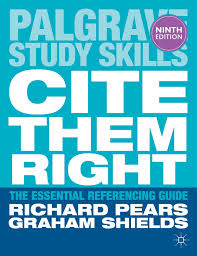Referencing Information
This section shows you how to properly reference the sources you use
1. How do I correctly reference my work?
1.4. The MHRA (Modern Humanities Research Association) Referencing Style

* There is now a new version of MHRA. Please see full details in Fourth (2024) edition of MHRA style, particularly chapter 7: Referencing on citing different sources from books, chapters , works of art, interviews...etc.
If you have been using the old version - the Third Edition, please check out Changes to MHRA Styles.
MHRA is a numeric referencing style published by the Modern Humanities Research Association.
Whenever you refer to another person’s words or ideas in your work, you need to insert a footnote number in your text. For example:
Giroux sums up how Disney transforms every child into a lifetime consumer of Disney products and ideas.1
When you refer to the publication for the first time, use full bibliographic details in the footnote.
Henry Giroux, The Mouse that Roared: Disney and the end of Innocence ( Rowland & Littlefield Publishers, 1999), p. 25.
*Note from above that the first name appears in full before the surname.
When you refer to the same book later on, you can provide the information in a shortened form:
Giroux, Mouse that Roared, p. 25.
*Note from above that just the surname is necessary.
The following are some examples of how different items are referenced:
Book
First name and surname of author, title of book (italicised, all important words capitalised) ( publisher, year of publication), page numbers (p. for one page, pp. for more than one page).
Philip Seargent, The Future of Language: How Technology, Politics and Utopianism are Transforming the Way we Communicate ( Bloomsbury Academic, 2023), p. 21.
Chapter from a book
First name and surname of author(s), title of chapter in single quotation marks, in title of book (italicised, all important words capitalised), ed. by first name and surname of authors(s) ( publisher, year of publication), page numbers (p. for one page, pp. for more than one page).
Martin Elsky, ‘Words, Things, and Names: Jonson’s Poetry and Philosophical Grammar’, in Classic and Cavalier: Essays on Jonson and the Sons of Ben, ed. by Claude J. Summers and Ted-Larry Pebworth (University of Pittsburgh Press, 1982), pp. 31–55 (p. 41).
Journal article
First name and surname of author, title of article in single quotation marks, title of journal (italicised), volume number (date of publication), page numbers of article (with specific page reference), doi number.
Doriane Zerka, ‘Constructing Poetic Identity: Iberia as a Heterotopia in Oswald von Wolkenstein’s Songs’, MLR, 114.2 (2019), pp. 274–93 (p. 279), doi:10.5699/modelangrevi.114.2.0274.
Website
Publication/name of author, title of article in single quotation marks, year published or last updated <URL> [date accessed].
The Economist , 'The Digital Degree', 2014 <http://www.economist.com/news/briefing/21605899-staid-higher-education-business-about-experience-welcome-earthquake-digital>; [accessed 28 July 2014].
The MHRA Style Guide does not contain an example of how to reference a lecture. The example below is based on the MHRA guidelines.
Lecture on QMplus
First name and surname of lecturer, title of lecture in single quotation marks, module code: module title (italicised). Year. Available at: URL of VLE [date accessed].
Stephen Henneberg, ‘Marketing Activities’, BUSM094: Introduction to Marketing Theory. 2014. Available at: http://qmplus.qmul.ac.uk/course/view.php?id=53 [Accessed 22 October 2014].
Live lecture
First name and surname of lecturer, title of lecture in single quotation marks, module code: module title (italicised). Location. Date of lecture.
Dr Phillipa Williams, 'Understanding 'Research' and Health Inequalities', GEG5013: Geographical Research in Practice. Queen Mary University of London. September 2014.
Learn more about the MHRA referencing style by using Cite Them Right Online: https://www.citethemrightonline.com/
You can find more books on referencing via Library Search.
Need help or advice about anything on this page? Contact Academic Skills Centre